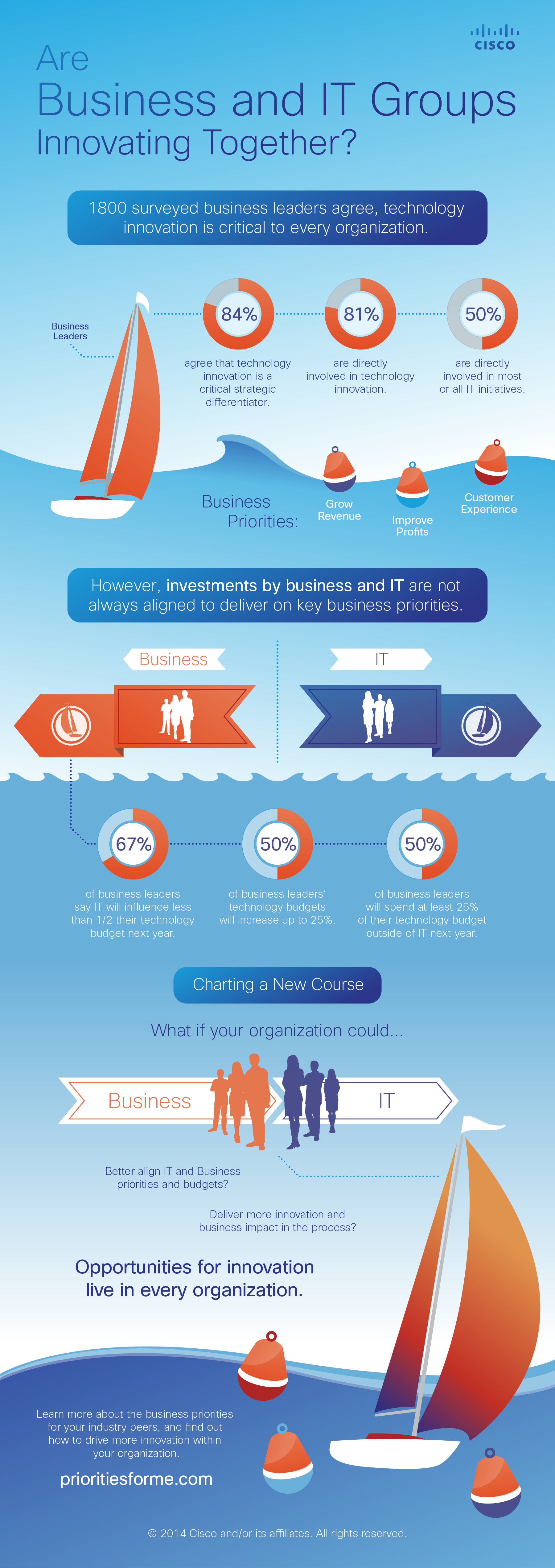 As business groups increase their technology investments and gain more access to new technologies and consumption models, IT’s balance between operational excellence and innovation is shifting. Technical innovation can now happen anywhere. This change presents a huge opportunity for IT to drive innovation in new ways. So which organizations are seizing this opportunity?
As business groups increase their technology investments and gain more access to new technologies and consumption models, IT’s balance between operational excellence and innovation is shifting. Technical innovation can now happen anywhere. This change presents a huge opportunity for IT to drive innovation in new ways. So which organizations are seizing this opportunity?
To find out, we recently conducted the Cisco Business and IT Priority Survey to determine how these groups manage innovation, and how their business and IT priorities are linked. See the info graphic and previous blog for global results and observations, and see how your priorities compare to your peers by taking the survey here.
As today’s innovation and technology investments can dramatically impact tomorrow’s business results, the investment levels by region are particularly interesting.
For example, 50% of business leaders in China see technology innovation as a critical differentiator to their business, whereas in the US, only 21% rank innovation as critical. Multiple times in the survey, the responses from China indicated a collective interest in innovation as a top business priority. In Germany, 23%, and the UK 25% of business leaders also see innovation as a business priority as critical.
Companies in India and China also indicate that their investments are growing faster than other regions’. About 81% of Indian business leaders surveyed, and 75% of Chinese ones expect their technology budgets to increase next year – many by more than 25%. By contrast, 54% of UK businesspeople, 48% in Canada and Germany, and only 41% in the US expect their technology budgets to grow.
Indian and Chinese business leaders also indicate that they’re spending a bigger proportion of their own growing budgets on technology. In China 82% of those surveyed plan to spend at least 25% of their business budgets on technology, and in India 71% are doing the same. By contrast, only 41% of US and 45% of Canadian business leaders are spending more than 25% of their budgets on technology.
To the extent that there’s any correlation between innovation investment and business advantage, perhaps eastern countries are poised to gain some innovation advantage in the near future?
Perhaps, but innovation is also affected by each company’s ability to leverage their IT expertise and infrastructure. Business leaders in India and the UK may be tapping into more of this potential, as they are much more likely to be directly involved in IT initiatives. In India, 80% are involved with most or all IT projects, and in the UK, 69% are, whereas only 35% of US business leaders and 42% of their Canadian counterparts participate in directly with IT. In China, about 61% of business leaders are involved in IT.
Despite these regional differences, increased investments are good news for all IT groups that can align and team with their business counterparts. And of course, how companies innovate is just as important as how much budget they spend on the process itself. So which companies are reaping the best return on their innovation investments? Here are a couple of examples:
- Houston Methodist hospital is transforming healthcare by delivering new treatment plans and diagnostic imaging processes with unified access
- Northrim Bank is reducing branch operating costs by 50% by integrating server, management, maintenance, licensing, and energy costs into one “office in a box” intelligent WAN solution
The common thread between these companies is the very clear alignment between IT and business initiatives. So how can organizations get better aligned? To start, you can participate in our ongoing Cisco Business and IT Priority Survey and see how your business priorities compare to your peers’. To participate, click here.


CONNECT WITH US